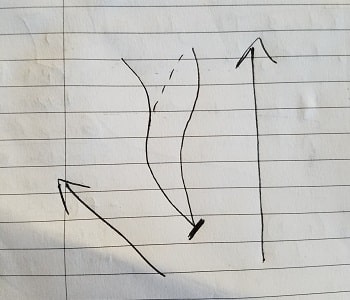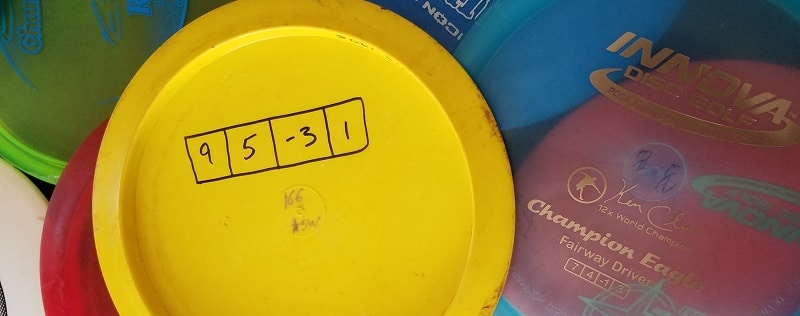Mastering a diverse range of throws is essential to take your game to the next level. With every course offering various obstacles, terrain, and wind conditions, having an arsenal of throws at your disposal can give you a significant edge. Here are 5 essential throws every disc golfer needs to master to improve their game and tackle any challenge on the course.
Blog Category: Flight
If you’re playing tournaments, one area that you can likely improve your game and focus is with a solid pre-shot routine. Routines can help you sharpen your focus by eliminating distractions, and helping you stay or get into a flow state.
I’ve been loving Gatekeeper Media’s slow motion “Form Check” replay videos. Here’s a few that I’m using to keep my own form in check. I’ll be adding more here as I come across them, and by all means check out Gatekeeper Media, they’re doing great things to support the sport.
Disc golf is great way to get out in nature, get your steps in and heart up, meet new people, and the sport is growing like crazy! I’m constantly running into new players every time I hit the course, from all walks of life. If you’re just starting out and want to improve your game, or know someone that is, let’s get started with our beginners guide to disc golf!
Disc golf terms seem to be many and there are lots of new concepts take some getting used to. The hyzer flip is one of those terms beginners have a hard time grasping and the definitions are wide ranging and so are the explanations. Learning how to throw the hyzer flip is a great addition to your game. If you’re a beginning disc golfer and looking to expand your shot selection start here. Most importantly, you can really learn to master those understable discs in your bag and put them to work for you. So if you are getting good rip on your discs and ready for something new, then I recommend getting to know the hyzer flip.
What is a Hyzer Flip & When to Use It
A correctly thrown hyzer flip will make an understable disc (a disc with a negative “Turn” rating) fly straight-ish. The hyzer flip can come in handy for long narrow shots. You usually get more distance out a straight hyzer flip, because you are using fast understable distance drivers.
Hyzer Angle

How to Throw The Hyzer Flip
First, you’ll need an understable disc. I prefer the Prodigy D3 or the Innova Leopard, or a beat-up or well-worn disc (see below for more recommendations). You’ll want to be aiming for a basket 300-400 feet away, straight out.

A hyzer throw is with the nose of the disc pointed down (see illustration). So a “hyzer flip” is basically a hyzered throw with an understable disc — which is where the “flip” comes in. You’ll want to keep the disc low to the ground — maybe 8 to 10 feet off the ground or so. Any higher and the glide might become a factor causing the flip to either turnover completely, or to activate the fade of the disc and sail off to the other direction. Keep it low. Remember the more understable the disc, the more you’ll adjust the release angle of the hyzer. Below, I’ve compiled another slideshow of videos on Youtube, explaining in different ways how to throw the hyzer flip — each with their own take on it.
Best Discs for the Hyzer Flip
This is by no means an extensive list, it’s just a small list to give you an idea of the best discs for the hyzer flip throw. I like beat up DX (Innova) or any baseline plastics with an understable disc, and discs that have just a mild to medium fade. Try the disc finder and look for drivers with a negative turn rating.
- Prodigy D3
- Discraft Crank
- Innova Sidewinder
- Innova Leopard
- Discraft Heat
- Discraft Flash
- MVP Impulse
- Innova Valkyrie
- Beat-up dx discs
More Resources
- No Comments
Disc golf flight numbers have widely been adopted by most disc golf manufacturers. The Speed, Glide, Turn, and Fade of a disc help disc golfers understand the flight path that a disc will have in the air. After all, not all discs will fly the same! Learning what each number represents can help you anticipate how you should throw and expect it to fly, making more accurate shots.
When I first started I pretty much just threw whatever plastic disc was available to me. Friends would throw out words like “overstable,” understable,” “hyzer,” and “anhyzer,” but I had trouble remembering and understanding, what each of those terms meant. As I progressed in the game, I began to understand that each disc has a different flight path — from the speed, glide, turn, and fade — and knowing what each disc can do well, and not so well, can really propel your game to the next level.
An important thing to remember with flight numbers is that they are just guidelines. Other factors will play into a disc and change their flight numbers. Some of these factors include plastic type, run of the disc (year), amount of wear, elevation, and weather.
Here’s what each disc flight rating represents:
Speed
Speed indicates how fast or slow the disc will fly, and how much power is needed to perform it’s designed flight path. The rating has a lot to do with the width of the rim of the disc. The wider the rim, the faster typically. If you need distance, then you need speed, but it can be harder to control. Typically, the faster you throw a disc the less it will fade and the more it will turn, but the speed of a disc can dictate how much fade and how much turn it will allow.
Glide
Glide is the ability to stay afloat in the air — which can affect the flight differently in different winds. As a measure of loft, a disc with a high glide number will maintain more time in the air. Low fading discs will drop faster to the ground.
Turn
Turn is the “stability” of the disc. The lower the negative number, the more a disc will “flip,” or “turn over.” Majority of discs will have a natural finish to one side. For a right backhanded shot a disc will naturally fade to the left at the end of flight. The turn indicates how much it will go in the opposite direction before it begins it’s low speed fade. The more negative the turn number, the more the disc will “flip” to the right (or left for a left handed backhand throw). A disc with a negative number is also referred to as “understable.” Discs with a higher negative number are also good to learn how to throw a backhand roller.
Fade
Fade is the finish of the disc after the inertia slows down — most discs will have natural fade to the left (for a right handed backhand throw) and some will have more than others. A higher fade number and the sharper the cut.
Disc Flight Ratings – Video Playlist (4)
I found a great 4 part video series from Best Disc Golf Discs, breaking down each rating, all are worth a watch:

- No Comments
Daily Ruminations
How to Quiet the Voices and Commit
Every disc golfer knows the feeling. You step up to a 20-foot putt with OB looming behind the basket. Your hand tightens on the disc. Your heart rate speeds up. You tell yourself, “Don’t miss this,” but deep down, you know the doubt is already there. And when you release the disc—just like you feared—it splashes out or sails long.
Why does this happen, even when you know you’re capable of making that putt? And more importantly—how do you stop it from happening?
The answer lies in the mental game. Physical skills only take you so far. If you want to reach the next level as a player, you need to train your mind just as much as your form. This post will walk you through a simple but powerful mental framework to quiet the negative voices, focus on execution, and start putting with real confidence.
Why Negative Thoughts Creep In
First, let’s clear something up: Negative thoughts during competition are completely normal. They’re not a sign of weakness—they’re just how your brain is wired.
🧠 The Brain’s Job is to Protect You
When you step up to a pressure putt, your brain perceives the situation as a threat.
-
The threat isn’t physical—it’s emotional.
-
Missing the putt might mean embarrassment, frustration, or even confirming a deep fear that you’re “not good enough.”
-
To protect you from that emotional pain, your brain tries to lower your expectations by feeding you negative thoughts:
➡️ “You’re going to miss this.”
➡️ “Don’t go OB.”
➡️ “Don’t blow it.”
This is your brain’s attempt to protect you from failure. But in reality, it creates the very outcome you’re trying to avoid. When you focus on avoiding failure, your body tightens up, your putting stroke gets mechanical, and you miss.
So how do you break this pattern? By shifting from a mindset of fear and consequence to a mindset of calm and execution.
6-Step Mental Game Reset
When you feel the negative voices creeping in, follow this mental reset to take back control:
1. Acknowledge the Thought (Without Engaging It)
When you notice the thought creeping in—“What if I miss?”—don’t fight it. Fighting the thought gives it power.
Instead, acknowledge it calmly:
✅ “That’s a fact. I don’t have to engage with it.”
Example:
➡️ “There’s OB behind the basket. That’s a fact.”
➡️ “That’s just noise—I don’t need to react to it.”
The moment you acknowledge the fear without attaching to it, you create separation between yourself and the thought. That stops the spiral before it starts.
2. Break the Pattern with a Physical Cue (Reset)
Negative thoughts create a physical reaction—tightness in your grip, quickened breathing, shaky hands. You need to reset both your mind and your body.
✅ Step away from your lie.
✅ Take a deep breath.
✅ Say a simple trigger word:
-
- “Commit.”
- “Smooth.”
- “Trust.”
This creates a hard reset between the negative thought and your next action.
3. Give Yourself a Positive Directive
Your brain needs a clear, positive instruction. Telling yourself “Don’t miss” focuses your mind on the negative outcome.
Instead, give yourself a positive directive:
✅ “Soft touch, center chains.”
✅ “Smooth release.”
✅ “Commit to the line.”
Positive commands lock your brain into execution mode rather than consequence mode.
4. Focus on a Small Target
Instead of aiming for the whole basket or gap, narrow your focus to a single spot, link or spot on the pole.
✅ This locks your mind onto a small target and prevents it from drifting toward the OB or imagining a miss.
✅ The smaller the target, the more precise your mind becomes.
Example:
➡️ “Hit that left chain link.”
➡️ “Aim for the center pole.”
Your brain can’t focus on fear when it’s locked onto a specific target.
5. Commit and Release (No Second-Guessing)
Once you’ve lined up, the thinking phase is over. Now it’s time to trust the process.
✅ You’re no longer trying to “make” the putt—you’re simply executing the stroke.
✅ Focus on the feel of the disc in your hand and the release—not the result.
Example:
➡️ “Commit and release.”
➡️ “Smooth stroke.”
➡️ “Follow through.”
6. Neutral Response After the Putt (Make or Miss)
If you make the putt—great. If you miss it—no emotional reaction. No frustration, no internal dialogue, no ego hit.
✅ Take a deep breath.
✅ Say: “Next shot.”
✅ Walk to the next hole with the same body language you’d have if you made it.
This is critical because if you give emotional weight to misses, your brain will learn to treat them as a threat. The goal is to make every putt feel emotionally neutral so your brain stops treating it like a life-or-death moment.
Example Scenario: Putting with OB Behind the Basket
❌ What Normally Happens:
-
You see the OB.
-
You think: “Don’t miss.”
-
Your hand tightens.
-
Your stroke becomes mechanical.
-
You miss.
✅ What This Looks Like With the New Process:
-
You see the OB.
-
“Yup, that’s OB. That’s a fact.” (Acknowledgement)
-
Step back. Deep breath. “Commit.” (Pattern Break)
-
“Soft touch, center chains.” (Positive Directive)
-
Focus on the feel of the disc. Small target. (Sensory Focus)
-
Smooth release. (Commitment)
-
If it misses: “Next shot.” (No Judgment)
💡 Why This Works
✅ You stop trying to control the outcome.
✅ You shift from a “fear of failure” mindset to a “trust in execution” mindset.
✅ You eliminate the fight-or-flight response by focusing on action instead of consequence.
🔥 Putting Mindset Cheat Sheet
-
Acknowledge: “That’s a fact—I don’t have to engage with it.”
-
Pattern Break (Reset): Step back → Deep breath → Trigger word.
-
Positive Directive: “Soft touch, center chains.”
-
Small Target: Focus on a single link.
-
Commit and Release: Feel the stroke, not the result.
-
No Judgment Afterward: “Next shot.”
💪 Final Thoughts: Confidence is a Skill
Most players think confidence comes from making putts. That’s backward. Confidence comes from how you respond to putts—both makes and misses.
➡️ Confidence is the result of training your mind to stay calm under pressure.
➡️ Confidence is knowing you can handle the outcome, no matter what it is.
➡️ Confidence is built on trust—and trust is built through process.
Start working this mental reset into your practice rounds and casual putting sessions. Once it becomes second nature, you’ll start walking up to every putt—whether it’s 15 feet or 45—with the same calm, focused energy.
That’s when the game changes. That’s when the chains start sounding different.
Comments0
“Success is a journey, not a destination. The doing is often more important than the outcome.”
– Arthur Ashe
Comments0
“Champions get hit over and over and over. You know, it’s the champion that decides to keep moving forward. It’s how many punches can you take and keep moving forward until you win.”
– Doc Rivers (from The Playbook)
Comments0
“At times you have to learn the steps to becoming a national champion, and one of those steps is losing, because it’s all about momentum, and momentum doesn’t mean it’s a positive thing. You can have momentum to lose and be defeated. You can have 24 hours to bask in your victory, or you got 24 hours to agonize in your defeat, and then we put one foot in front of the other and keep moving forward.”
– Dawn Staley
Comments0
“The key to success is to focus our conscious mind on things we desire not things we fear.”
– Brian Tracy
Comments0
Blog Menu
Grow the Sport
These great organizations are growing the sport of disc golf both locally and globally. Consider taking some time to see what they are doing and get involved! Have another? Contact us!

